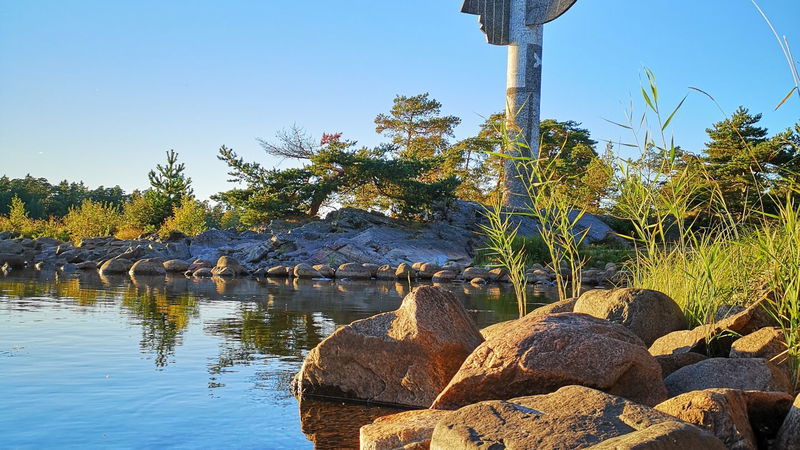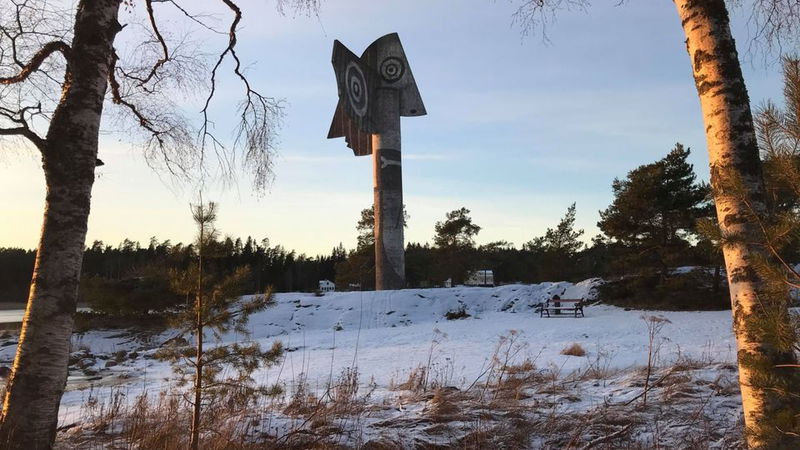Discover the Picasso sculpture by Lake Vänern in Kristinehamn – an impressive art experience and part of the world’s largest Picasso artwork. Enjoy the art with the horizon of Lake Vänern in the background.
During September, the Picasso sculpture is being carefully restored. This means parts of the sculpture are covered by scaffolding.
Even during the restoration, you can see parts of the sculpture, enjoy the impressive view of Lake Vänern, and explore an outdoor exhibition with signs about the artwork and its history.
Thank you for your understanding. We look forward to showing the sculpture in full again soon!
By the shores of Lake Vänern, surrounded by the beautiful archipelago, stands one of the world’s largest Picasso sculptures – a monumental artwork that attracts visitors from all over the world. This 15-meter-high sculpture is more than just a piece of art; it is a symbol of creativity, collaboration, and a place where art and nature meet.
In 2025, the sculpture celebrates its 60th anniversary. In 2024, she got a thorough cleaning, and now during August–September 2025, she is getting a "facelift" — a restoration to help her stay beautiful for all the visitors who come to see her. This means there will be scaffolding on site.
The Picasso Sculpture, inaugurated in 1965, is one of the largest Picasso artworks in the world. It is made from natural concrete and sandblasted with artistic patterns designed to last for thousands of years. The sculpture was created by Picasso in collaboration with Carl Nesjar and Bengt Olson and stands today as a tribute to both artistic vision and historical commitment.
But the Picasso Sculpture is not only an artwork – it is also a part of Kristinehamn’s identity and a place where both nature and culture go hand in hand. Take a walk along the promenade, enjoy the view of Lake Vänern, or simply stand and admire this colossal sculpture.
Walk Along the PromenadeTake a stroll along the beautiful Vålösundet promenade, or cycle part of the Vänerleden trail.
Guided ToursDelve deeper into the history and significance of the sculpture by booking a private guided tour – available in both Swedish and English.
Explore NatureExperience the Vänern archipelago by boat or on foot – don’t miss the stunning views over Lake Vänern.
Eat and DrinkEnjoy a delicious meal or coffee at one of the many nearby cafés and restaurants, such as Picasso’s Veranda, Nock, Café Pärlan, Skymningen, and Restaurant Trossen.
Exhibit SignageAlong the eastern point, you’ll find informative signs about the sculpture and its fascinating history.
It all began on a dusty road in France in the 1960s. Kristinehamn-born artist Bengt Olson met Norwegian sculptor Carl Nesjar, who was collaborating with Pablo Picasso. Picasso, fascinated by the artistic potential of concrete, had already started working on a series of sculptures with Nesjar.
Nesjar mentioned that one of these works could be made for 150,000 SEK – and there was urgency! New York was interested, but Olson saw a unique opportunity for Kristinehamn. After a swift campaign, with pictures and folk music selling the location to Picasso, a donation letter was sent. On a photo of the model at Strandudden, Picasso wrote “Oui, Picasso 7.7 1964.”
In the link to Swedish Radio, you can hear Bengt Olson’s fascinating story about how everything came together.
On Midsummer’s Eve in 1965, the Picasso sculpture was unveiled with a public celebration, with author Bo Setterlind giving the opening speech. Picasso followed the work through film but never had the chance to see his sculpture on site. However, many others have had the privilege, and today the Picasso sculpture remains one of Kristinehamn’s most popular attractions.
Facts About the Sculpture
- Inaugurated: 1965
- Height: 15 meters
- Weight: 35 tons
- Diameter of the pillar: 1.65 meters
- Span: 6x4 meters
- One wing weighs: 8 tons
- Material: Natural concrete, sandblasted decor
- Restoration: The sculpture was cleaned in the autumn of 2024 and will undergo further restoration in August 2025.
In 2025, the Picasso sculpture will celebrate its 60th anniversary. Jacqueline has stood in Kristinehamn for six decades, and to ensure it remains an artistic monument for future generations, restoration is of the utmost importance. The sculpture has undergone a careful cleaning and will continue to be cared for to ensure its longevity.
Want to know more about the sculpture and its history? Book a private guided tour in Swedish or English. Learn more about Picasso’s artwork and the exciting story of how it ended up here in Kristinehamn.
Read more about what to see and do in the Picasso area.
Guided tours of the Picasso sculpture can be booked in English – read more.




